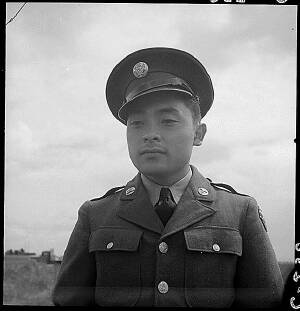EVIDENCES OF AMERICANISM AMONG
JAPANESE-AMERICANS
Statement by Dillon S. Myer,
Director of the War Relocation Authority
Statement by Dillon S. Myer,
Director of the War Relocation Authority
In view of the fact that the Japanese side of Japanese-American life has been so strongly emphasized during recent weeks, I believe that, in the interest of fairness and accuracy, some attention should be drawn to evidences of Americanism among the Japanese-American people.
Of the 110,000 people of Japanese descent who were evacuated last year from the Pacific Coast military area, approximately 70,000 were born in the United States and are American citizens. Roughly 72 percent of this group have never even seen Japan. They have attended American public schools and have been subjected to all the other Americanizing influences that operate constantly in any American community.
More than 8,000 Americans of Japanese ancestry -- approximately half of them volunteers -- are now serving in the United States Army. Some are in
 service overseas and three have already been cited for bravery in
action. One is serving as a turret gunner in Liberator engaged in
bombing operations over the Continent of Europe. [PHOTO: "This 23 year
old Nisei soldier volunteered for army service July 10, 1941 and is
stationed at Camp Leonard Wood, Missouri. He obtained a furlough to
assist his mother and family prepare for evacuation. He is the youngest
of six children, two of whom are volunteers in the Army of the United
States." (Florin, Calif., 05/11/1942)]
service overseas and three have already been cited for bravery in
action. One is serving as a turret gunner in Liberator engaged in
bombing operations over the Continent of Europe. [PHOTO: "This 23 year
old Nisei soldier volunteered for army service July 10, 1941 and is
stationed at Camp Leonard Wood, Missouri. He obtained a furlough to
assist his mother and family prepare for evacuation. He is the youngest
of six children, two of whom are volunteers in the Army of the United
States." (Florin, Calif., 05/11/1942)]Over 1,200 of these soldiers volunteered for service behind the wire enclosures of relocation centers. As a result, the centers today contain large numbers of service flags and other evidences of ties with the Army. Men in uniform are frequent visitors at the centers and arrangements for entertaining them are part of the regular community activities program.
There are many other evidences of Americanism among these people both in the relocation centers and in normal communities throughout the country. At all centers, training in American ideals and American institutions is part of the regular school program just as it is in public schools outside. Formal flag raising and the pledge of allegiance are a regular ceremony in most of the center schools. Practically all national organizations for young people -- such as the Boy Scouts, Girl Scouts, 4-H Clubs, YMCA, YWCA, and Junior Red Cross -- have active programs at the centers and many thousands of members. Boy Scouts alone number several thousand.
Outside the relocation centers, the thousands of Japanese-Americans -- including both those who have left the centers on leave and those who were never evacuated -- are displaying their patriotism in the same ways as other civilian Americans. They are buying war bonds and stamps, donating money and blood to the Red Cross, and participating in salvage campaigns. Several hundred are serving effectively in the intelligence branch of the United States Army. Others are serving as language instructors, helping to train intelligence officers for the Army and Navy. Still others are working as translators with the Overseas Branch of the Office of War Information. Many are employed as carpenters, machinists, welders, and in other jobs essential to war production.
Presented before
Costello Subcommittee of House Committee on Un-American Activities
July 7, 1943
Costello Subcommittee of House Committee on Un-American Activities
July 7, 1943
-- Table of Contents --